Sicily is famed for its lemons. Fortunately, John Scott discovers that Sicilian amplifier manufacturer Audiozen’s Alchemy amp is a bit of a peach at £3091.
UNBOXING, CONSTRUCTION, AND APPEARANCE
The Audiozen Alchemy amplifier arrived in an impressively large, sturdy and heavy wooden packing case, branded with the Audiozen logo. Fortunately, my cordless drill had retained just enough power to enable it to unscrew the top of the case as I suspect there may have been a small degree of shouting and swearing if I had been required to exert my puny muscles to remove the screws. Solid, secure packaging is to be applauded though, and as my drill wheezed out its dying breath just as the final screw was removed, I lifted the top of the case to see that its contents were well-protected by the thick foam paneling glued to each of the interior sides. This was also supplemented by polythene packaging and bubble wrap.
It would be reasonable to expect that an integrated amplifier would be a single-box affair but the Alchemy is a two-box design, coming with its own separate power supply that powers both the pre and power sections of the second unit.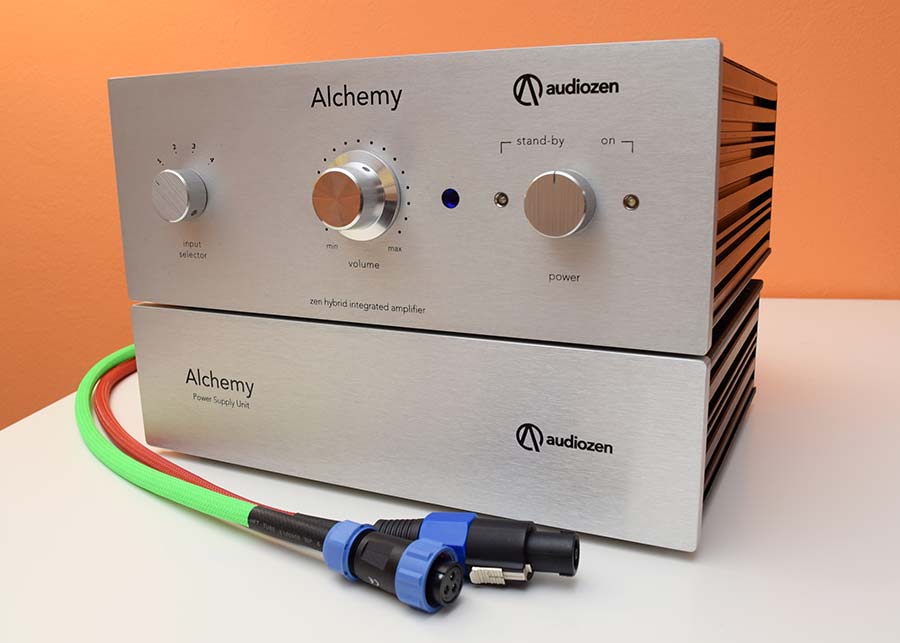
First out of the packing crate was the amplification unit. This was surprisingly light in weight but I was soon to find our why; the weight was all in the substantial power supply unit, with its three substantial toroidal transformers. Were these two units combined into a single box, it would come in at around 13kg. The units are slightly mismatched in size (the pre/power amp measuring 135 x 340 x 295mm and the power supply unit 95 x 340 x 245mm) but make an attractive pair when positioned either side by side on a shelf or on individual shelves. Marketing photos show the pre/power amp perched directly on top of the power supply but I wouldn’t recommend this in practice; the top plates of both units I was supplied with bowed slightly when any weight was put on them. Having said that, I understand that future models will have improved cross bracing.
Both units have attractive brushed aluminium faceplates although a black finish is available on request. Audiozen have opted for a fairly minimalist, uncluttered design that speaks quietly of quality rather than shouting about its price tag. The power supply boasts discreet lettering and logos on its front panel and the amplifier unit is only slightly more ostentatious with the same lettering/logo combination and three solid rotary knobs – source selection, volume and stand by/on switch.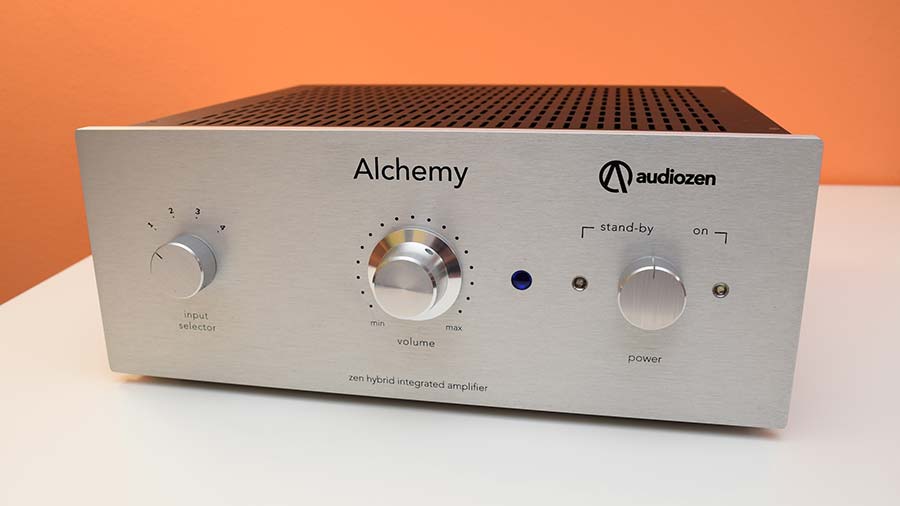

SET UP
The connection of the power supply to the amp is achieved via two chunky power cables, one green and one red; one screw connection and one bayonet to prevent them from being mixed up. Having connected these, all that is left is to connect your speaker cables to the binding posts – bare wire, spades or banana plugs are accommodated – connect up to four of your chosen sources to the RCA inputs, plug in the mains cable to the power supply, switch it on and you are good to go. Almost. Audiozen recommends warming up the two NOS (New Old Stock) E88CC valves in the preamp section for a few minutes ( I went to put the kettle on) before turning the rotary switch to the right to turn the amp fully on.
The last thing to mention before we get down to how the Alchemy sounds is the remote control. This is something that is a particular bugbear with me; I feel strongly that the quality of a remote control should be commensurate in quality with the equipment that it partners. Unfortunately, while the Alchemy exudes elegance, the same can not be said of the oversized plastic remote. At this price point, I think Audiozen should seriously reconsider this.
SOUND QUALITY
Since I’d gone to the trouble of boiling the kettle, I settled down with a cup of coffee and an album I know like the back of my hand: Mike Oldfield’s 2009 remix of Tubular Bells. Immediately, I found that adjusting the volume using the remote was entirely hit or miss; the Alchemy is a high gain amp and it only takes a very slight adjustment of the volume knob to achieve significant differences in volume level. As I tapped the + and – buttons on the remote, I watched the motorised volume knob move back and forward between not quite loud enough and slightly too loud. I decided to manually set the volume knob and use the volume slider on the iPad app that I use to control my digital library for fine adjustment. Since I carried out this review, Audiozen has reduced the amp’s gain by 4db so more precise volume adjustment should be possible with future models.
Back to the music. As I moved through Tubular Bells Part 1, from the famous “Exorcist” introduction to Viv Stanshall’s introduction of the various instruments near the end, I was struck by the Alchemy’s ability to pull out detail while keeping the very many different elements of the piece integrated into a cohesive musical experience. On previous listenings, I’ve frequently found that subtle details can struggle to cut their way through everything else that is going on but that was certainly not the case here.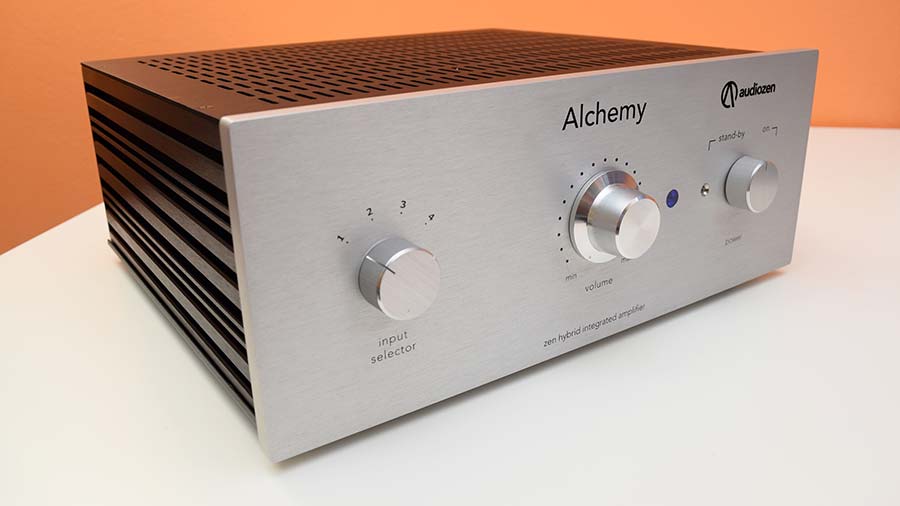
I moved on to some very different types of music: Iron Bar Dub from Linton Kwesi Johnson’s LKJ In Dub allowed the Alchemy to show off its capabilities right across the frequency spectrum. Bass was deep but tightly controlled, the hi-hat cymbals were cleanly presented without any tizz and there was really impressive detail in the dub reverb effects; so good that I just had to play it again. Moving on to Find The River from REM’s Automatic For The People, the Alchemy presented the track as if it was played live in the studio. In reality, the recording is no doubt made up of multiple takes and overdubs but there was a sure sense of the performance taking place right there in front of me. SuperBass 2 by Ray Brown, Christian Mcbride and John Clayton sees the three jazz bass virtuosos perform in what is very definitely a live performance. Their take on Papa Was A Rolling Stone contains a mix of frantic plucked and bowed double bass playing and it’s all too easy for this to come across as a bit of a confused mess. The Alchemy made a good fist of this though, separating out the three instruments in the soundstage and picking up on the atmospherics of the performance and the enthusiasm of the audience.
All in all, the Alchemy was unfazed by whatever I threw at it during the period of the review and I always found myself looking forward to spending time with it, which is always a good indication that a piece of hi-fi kit is doing its job well.
CONCLUSION
Audiozen’s Alchemy sits within a crowded segment of the HiFi market, but its discrete power supply and hybrid valve/solid state pre/power design help it to stand out from the crowd. Refined in both looks and sound, if you are considering an integrated amp at this price point then the Alchemy deserves to be on your audition list.
Elegantly understated in both looks and functionality, the Alchemy simply gets on with doing what it was designed to do – producing an involving, musical experience time after time.
Build Quality: Both the amplifier and power supply units are finished to a high standard. As mentioned above, the slight weakness to the top plate of the units has now been addressed.
Sound Quality: Engaging and entertaining, the Alchemy regularly kept me up past bedtime as “let’s have one more tune” saw the time just slipping away. Fully capable of being punchy and dynamic when the occasion demands, the Alchemy’s real strengths are in its elegant subtlety, it knows how to deliver without having to shout about it.
Value for Money: While not a giant killer that tries to punch above its weight, the Alchemy is a highly capable performer at its price point and will provide years of enjoyment.
Pros: Good looks and quality manufacturing and it sounds even better than it looks. Separate power supply sets it apart from the crowd.
Cons: I really didn’t like the remote.
Price: £3091.00
John Scott
Technical Specifications
Output power @ 8 Ω – 90 W per channel
Output power @ 4 Ω – 170 W per channel
Class – AB
Frequency response – 5 – 100.000 Hz +/- 3dB
Sensitivity/input impedance – 180 mV/100 KΩ
Signal-to-noise ratio – 98 dB
NOS tubes – 2 x E88CC (6BZ7/6BS8)
Unbalanced inputs – 4
Available finishes – silver (black upon request)
Main unit dimensions – 340 x 135 x 245 mm (W x H x D)
Main unit weight – 4,5 Kg
PSU dimensions -240 x 95 x 295 mm (W x H x D)
PSU weight – 7,3Kg











































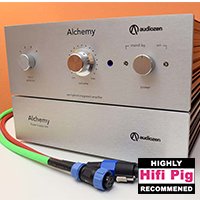
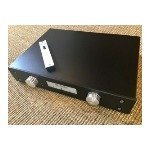




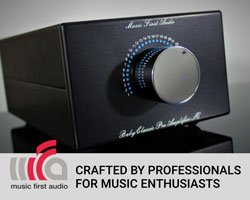




















































































































You must be logged in to leave a reply.